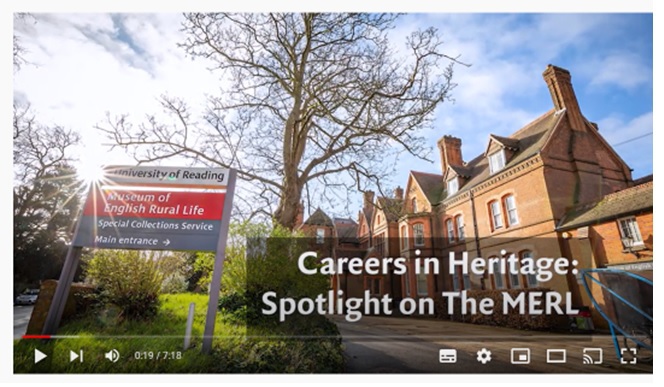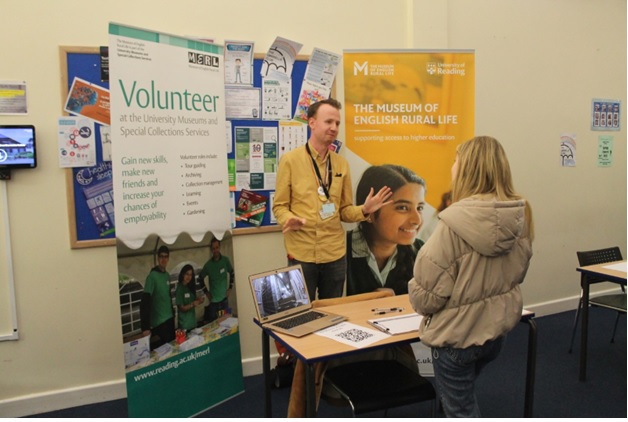Widening participation at The MERL
Highlights from three years of working with young people
Written by Adam Lines, The MERL’s Widening Participation Project Officer
Almost three years ago, The MERL learning team embarked on a new programme of widening participation. Our aim was to facilitate new opportunities at the museum for young people in schools from areas of low and non-participation in higher education. We looked to support these students in discovering the museum’s collections, learning new skills, and building confidence. As a university museum, part of the University of Reading, we are uniquely placed to build connections between young people and higher education, and for people growing up in Reading, a visit to The MERL is often a young person’s first experience of a university campus.
Over the last three years, we have reached 1,216 young people across 57 sessions, workshops, and supported placements. We have built strong links with local schools and teachers, and tailored bespoke learning sessions for a wide variety of classrooms and outreach events.
In this blog, join us as we reflect on some of the highlights from our widening participation work in the last three years.
Going virtual: museum learning during the pandemic
Just as we started to get going with our widening participation sessions, the COVID-19 pandemic arrived. Like people and organisations across virtually every sector across the globe, we were faced with the enormous challenge of fundamentally rethinking the delivery of our work. How would we reach classrooms when the schools were closed?
Alongside our colleagues throughout the museum, we invested in ways of reimagining our work so that engagement was virtual rather than in person. We undertook some speedy upskilling and training around using different technologies, and reimagined what our sessions looked like. Before long, we were joining schools online through live video calls, supplemented by digital resources prepared and sent in advance. This reimagining allowed us to keep widening participation, despite the difficult circumstances, delivering museum experiences to students at a time when imagination and curiosity was most in need.

The digital assets we created to support our virtual delivery have not only proved crucial over the past couple of years, but provide us with additional resources that we continue to use today. One example is a careers in heritage film, featuring short interviews with a variety of colleagues about their roles and work. It remains highly popular with schools, assemblies, and career sessions. Another is our work in 3D photogrammetry, creating 3D digitised models of objects from The MERL collection. Whilst they let us share the collections with students during the pandemic, today these models help us broaden access and share museum objects with students who otherwise may be unable to take part.
Connecting with the land
We have worked with several different schools and colleges to tailor unique learning programmes around each of their curriculums.

One such programme took shape this spring, as we worked with teachers and year 7 students from Reading Girls’ School. The school’s timetable for its year 7 pupils features dedicated STEM curriculum days, when the students are tasked with producing ideas to help repair our planet. To do this, the school provided the pupils with space in the school grounds to develop conservation projects and cultivate the land. A key part of this programme became a series of seven half-day visits to The MERL, with approximately 260 pupils taking part!
During the students’ visits to the museum, colleagues from departments across the University of Reading were invited to join us and share their pioneering work in fields of cultivation, environment, and climate. The students were given opportunities to respond creatively to these talks and come up with their own solutions. Crucially, they were able to learn how these academics found their way to University and envisage what could be possible for themselves.
Each of these talks was complemented by related learning activities, combining hands-on engagement with the collections and worksheets. These focused on supporting the students to develop key skills, such as critical thinking, debate, and communication.
The world of work: placements at The MERL
It’s been a joy to welcome students to the museum on supported work placements from a range of schools, particularly those with SEND students.
Each of these placements lasted several weeks and was tailored to the needs of the student and the skills they were seeking to develop. Through a process of consultation with teachers at the school, and a pre-placement interview with the young person, we created each placement with the aim of enabling the student to gain insight and experience in relevant aspects of museum roles and work.
On one placement, a student used their time with us to complete their Arts Award. They produced an exhibition of their work inspired by the collections. We’ve also been able to increase students’ confidence in the workplace. One of our work placement students has applied for the Ways into Work scheme as a result of their time with us and the difference it made to them. Another said, ‘This museum was the best experience and I have learned so much history about the people and animals in the countryside. I feel very proud and happy as I have always wanted my art in a museum and my dream has come true!’

We’ve also attended careers fairs at a variety of local schools and spoken in school assemblies and classes about different careers and roles in heritage.
Find out more about learning at The MERL
This blog features just some of the many strands of activities we planned, developed and delivered in the last three years. Our motivation comes from the possibility to improve the futures of young people. And there’s nothing more inspiring than to hear from them about the difference their time at the museum has made!
If you would like to discover more about our work with schools, or speak with a member of The MERL learning team, then please email the museum’s Widening Participation Project Officer or visit our widening participation page.
